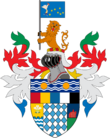Constituencies of Phinbella: Difference between revisions
No edit summary |
No edit summary |
||
| Line 2: | Line 2: | ||
{{About|districts for electoral purpose|territorial administrative purpose|Collectivities of Phinbella}} | {{About|districts for electoral purpose|territorial administrative purpose|Collectivities of Phinbella}} | ||
{{Politics of Phinbella}} | {{Politics of Phinbella}} | ||
'''[[Wikipedia:Constituency|Constituencies]] of the Free area of the Federation''' or '''Estates of the Federation constituencies''' are electoral divisions in the [[Free area of the Federation]] where all are represented by one seat only in the [[Estates of the Federation]]. | '''[[Wikipedia:Constituency|Constituencies]] of the Free area of the Federation''' or '''Estates of the Federation constituencies''' are electoral divisions in the [[Free area of the Federation]] where all are represented by one seat only in the [[Estates of the Federation]]. Until now, there are as many as 132 Estates constituencies elected in a three-year term by one seat, of which 130 are geographical constituencies and the other two are constituencies representing aboriginal communities. The structure of both categories of constituencies is likely to undergo major changes throughout their history. | ||
Unlike federal constituencies, each Estates constituency contains approximately two to eight (or even up to ten) territorial or regional constituencies, with the exception of aboriginal constituencies. As in | Unlike federal constituencies which are electoral divisions in [[Phinbella]] itself, each Estates constituency contains approximately two to eight (or even up to ten) territorial or regional constituencies, with the exception of aboriginal constituencies. As in Phinbella and other entities, constituency boundaries and administrative collectivity or administrative district boundaries may cross each other and not correspond to each other in most cases, but Estates constituencies may not cross territorial or regional boundaries. Estates and territorial or regional constituencies are numbered, and usually Estates constituencies are denoted by P.''xxx'', while territorial or regional-level constituencies are denoted by one or two initial letters of the vehicle registration plate, for example A.''xx'' in [[Kamoveropo]] and KH.''xx'' in [[Territory of Kota Hilir|Kota Hilir]], except in [[Phinbellan Maritime Territories]] where it is denoted by D.''xx'' and [[Tanah Tōnán'hyôrï]] is denoted by TT.''xx''. | ||
Just like the federal electoral area, the boundaries of the electoral districts in the Free area of the Federation are also not permanent and the Federal Election Commission can review and reset the boundaries at intervals of not less than 6 to 10 years. In {{RP|2022}}, the [[Phinbella Federal Legislative Assembly|Phinbellan Federal Legislative Assembly]] proposes to change the boundaries of the constituencies in this entity because the changes occur in the demarcation of territories in Phinbella, it includes the dissolution of some territories and integrated into other existing territories, it will happen before the dissolution of Estates for the first time, and there will be an election in this entity. | |||
== Summary == | |||
Revision as of 12:24, 12 November 2022

|
This article or section is a work in progress. The information below may be incomplete, outdated, or subject to change. |
 |
|---|
|
|
|
|
Constituencies of the Free area of the Federation or Estates of the Federation constituencies are electoral divisions in the Free area of the Federation where all are represented by one seat only in the Estates of the Federation. Until now, there are as many as 132 Estates constituencies elected in a three-year term by one seat, of which 130 are geographical constituencies and the other two are constituencies representing aboriginal communities. The structure of both categories of constituencies is likely to undergo major changes throughout their history.
Unlike federal constituencies which are electoral divisions in Phinbella itself, each Estates constituency contains approximately two to eight (or even up to ten) territorial or regional constituencies, with the exception of aboriginal constituencies. As in Phinbella and other entities, constituency boundaries and administrative collectivity or administrative district boundaries may cross each other and not correspond to each other in most cases, but Estates constituencies may not cross territorial or regional boundaries. Estates and territorial or regional constituencies are numbered, and usually Estates constituencies are denoted by P.xxx, while territorial or regional-level constituencies are denoted by one or two initial letters of the vehicle registration plate, for example A.xx in Kamoveropo and KH.xx in Kota Hilir, except in Phinbellan Maritime Territories where it is denoted by D.xx and Tanah Tōnán'hyôrï is denoted by TT.xx.
Just like the federal electoral area, the boundaries of the electoral districts in the Free area of the Federation are also not permanent and the Federal Election Commission can review and reset the boundaries at intervals of not less than 6 to 10 years. In RP 2618, the Phinbellan Federal Legislative Assembly proposes to change the boundaries of the constituencies in this entity because the changes occur in the demarcation of territories in Phinbella, it includes the dissolution of some territories and integrated into other existing territories, it will happen before the dissolution of Estates for the first time, and there will be an election in this entity.